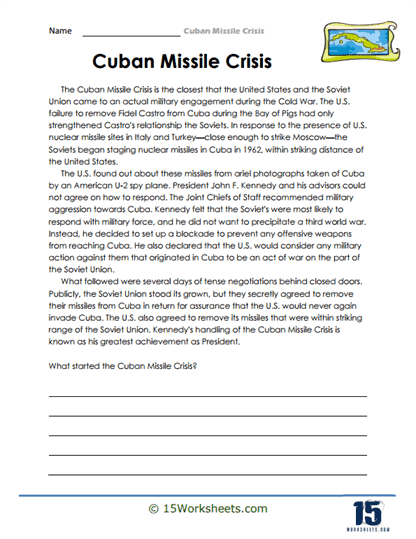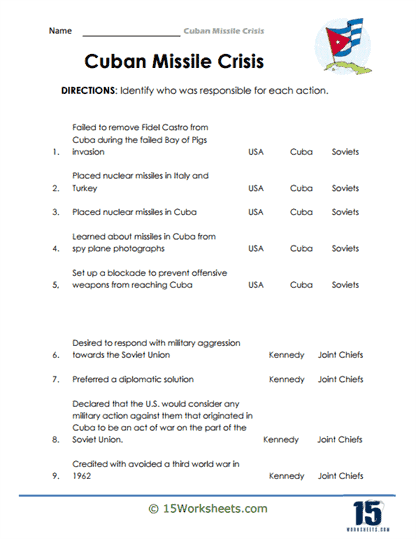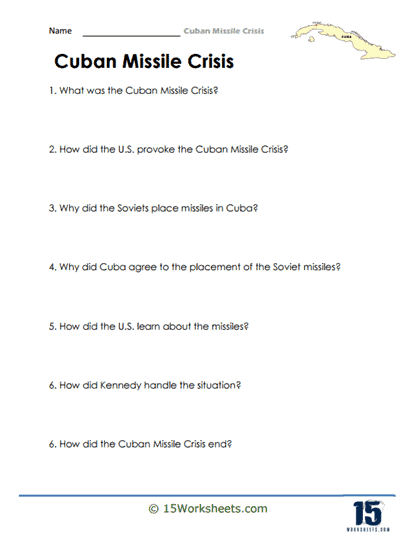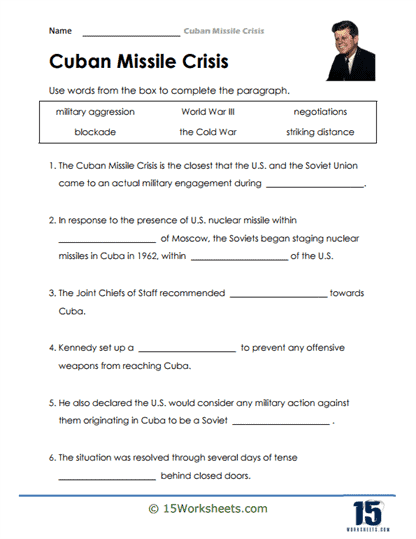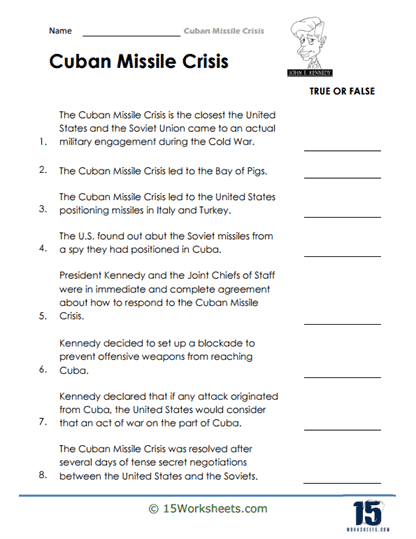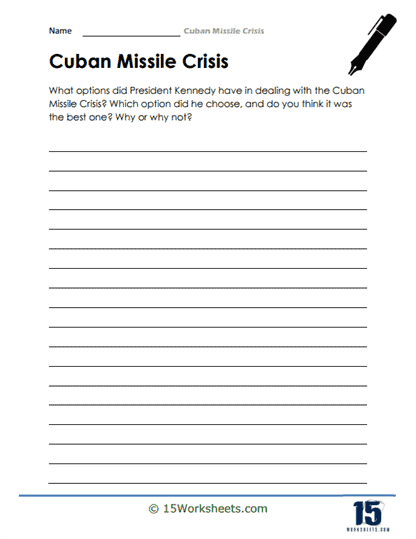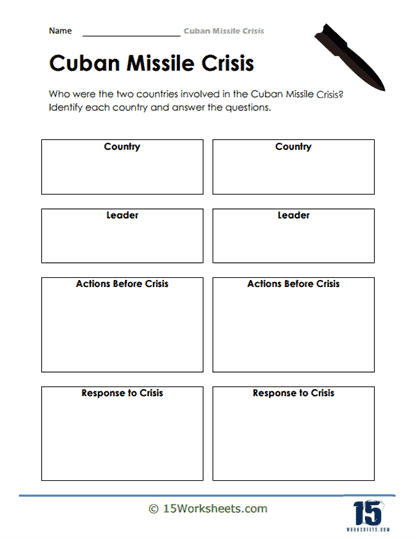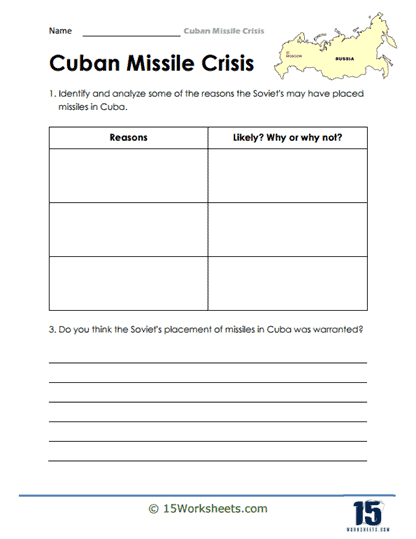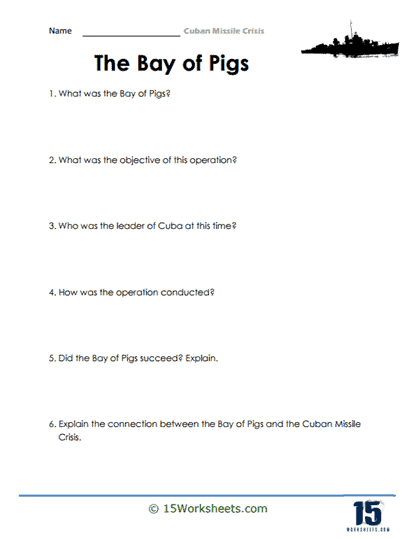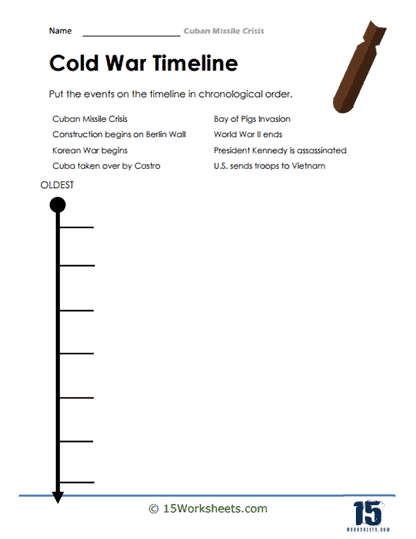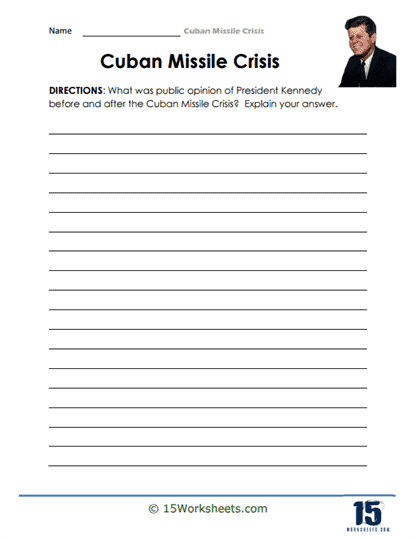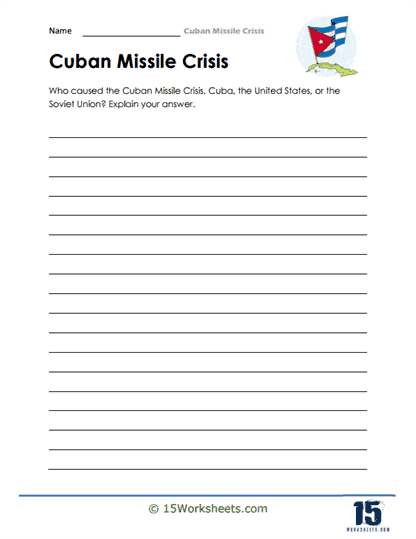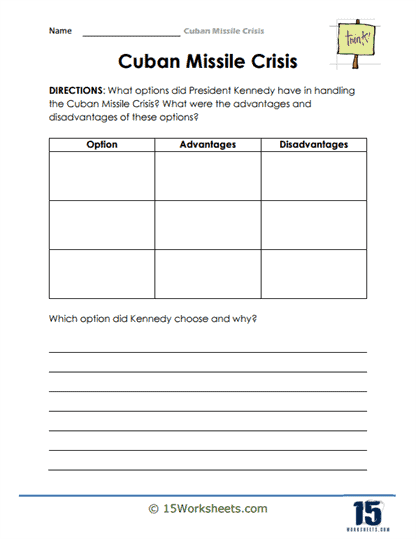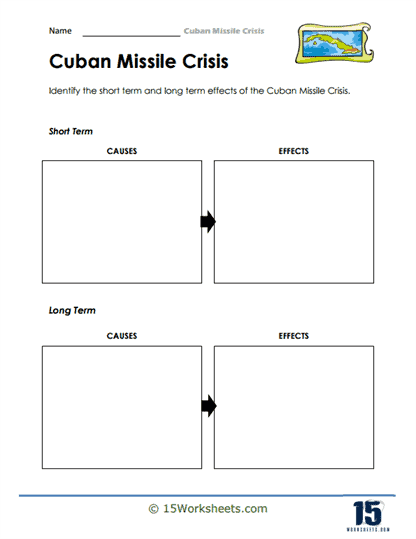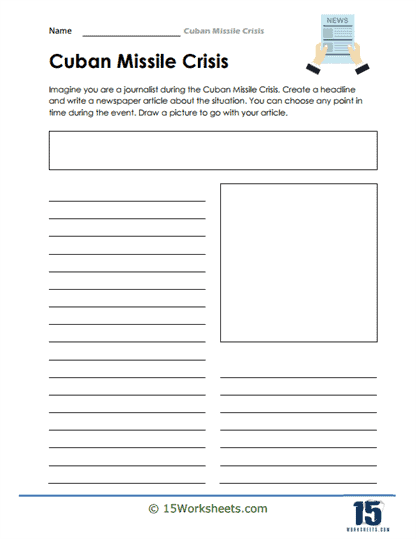Cuban Missile Crisis Worksheets
All About These 15 Worksheets
This series of 15 worksheets discusses one of the most critical moments in modern history, the Cuban Missile Crisis. The exercises are designed to immerse students in the dramatic events and high-stakes diplomacy surrounding this Cold War confrontation. Through engaging activities and thought-provoking exercises, students will gain a deeper understanding of the causes, impact, and resolution of the Cuban Missile Crisis, while exploring the implications for global politics and the dynamics of the Cold War. Through these worksheets, students will:
- Explore the historical context, the escalating tensions between the United States and the Soviet Union, and the events that led to the crisis;
- Examine the role of the USA, Cuba, and the Soviets in the key events;
- Reflect on President Kennedy’s actions in dealing with the crisis;
- Identify the short and long term effects of the crisis, considering the long-term implications for U.S.-Soviet relations and nuclear disarmament efforts;
- Put the key events in the correct sequence across a timeline;
- Showcase their knowledge through fill in the blanks exercises, true or false questions, and writing prompts;
- And hone their creativity by creating their own news headline and article, putting themselves in the shoes of a witness writing a first-hand account of a particular event during the crisis.
Completing this series of worksheets will transport students back to the tense days of the Cuban Missile Crisis, fostering a deep understanding of the complexities, risks, and diplomatic strategies that shaped this pivotal moment in history. Through a wide range of activities and exercises, students will develop critical thinking skills, historical empathy, and a greater appreciation for the importance of diplomacy in averting global conflicts. Overall, this series aims to inspire students to explore the lessons learned from the Cuban Missile Crisis and to reflect on the significance of peaceful resolution in international relations.
What Was the Cuban Missile Crisis?
The Cuban Missile Crisis was a 13-day confrontation between the United States and the Soviet Union in October 1962, which brought the world to the brink of nuclear war. The crisis was triggered by the discovery of Soviet missile installations in Cuba, which had the potential to launch nuclear attacks against the United States. The event marked one of the most dangerous episodes of the Cold War, and its successful resolution highlighted the importance of diplomacy, communication, and crisis management in averting a catastrophic conflict. This article provides an in-depth analysis of the Cuban Missile Crisis, the factors that led to the confrontation, and the lessons learned from this critical juncture in history.
To understand the Cuban Missile Crisis, it is important to examine the broader context of the Cold War and the specific events that led up to the crisis. The Cold War was a period of geopolitical tension between the United States and its Western allies and the Soviet Union and its Eastern Bloc allies. This struggle for global dominance, which lasted from 1947 to 1991, was characterized by ideological, political, economic, and military competition between the two superpowers. The Cuban Missile Crisis was one of the most dramatic examples of the military dimension of this conflict.
The Cuban Revolution and the Rise of Fidel Castro
The Cuban Revolution, which took place between 1953 and 1959, was a key factor in setting the stage for the Cuban Missile Crisis. The revolution, led by Fidel Castro, overthrew the US-backed Cuban dictator Fulgencio Batista and established a socialist government in Cuba. Castro’s regime soon forged close ties with the Soviet Union, leading to increased tension between Cuba and the United States.
The Bay of Pigs Invasion
The United States’ concerns about Cuba’s alliance with the Soviet Union and the potential for communist expansion in the Western Hemisphere led to the Bay of Pigs invasion in April 1961. This unsuccessful attempt by the US to overthrow Castro’s government further strained US-Cuban relations and reinforced Cuba’s alliance with the Soviet Union. The invasion also contributed to Soviet leader Nikita Khrushchev’s decision to place nuclear missiles in Cuba, as he believed that the US would continue to pose a threat to the Cuban government.
The End Result
The end result of the Cuban Missile Crisis was a negotiated settlement between the United States and the Soviet Union that ultimately averted a nuclear conflict. On October 28, 1962, Soviet Premier Nikita Khrushchev agreed to dismantle and remove the nuclear missiles from Cuba. In return, President John F. Kennedy publicly promised not to invade Cuba and privately agreed to remove US Jupiter missiles from Turkey, although this part of the agreement was not disclosed to the public at the time.
The resolution of the Cuban Missile Crisis marked a turning point in the Cold War, as both superpowers recognized the need to improve communication and establish mechanisms to prevent future crises from escalating to the brink of nuclear war. Following the crisis, a series of agreements were signed to improve communication between the US and the USSR, including the establishment of the Moscow-Washington hotline, also known as the “red telephone,” to facilitate direct communication between the leaders of the two countries. Additionally, the crisis paved the way for the Limited Test Ban Treaty in 1963, which banned nuclear weapon tests in the atmosphere, outer space, and underwater.
In summary, the Cuban Missile Crisis showcased the dangers of nuclear brinkmanship and highlighted the importance of diplomacy and communication in averting potential conflicts between global powers.

